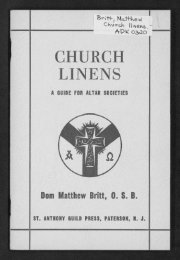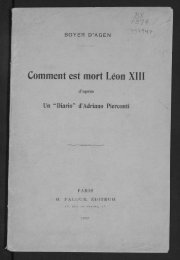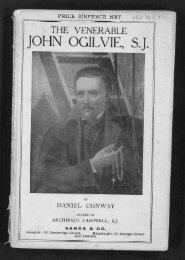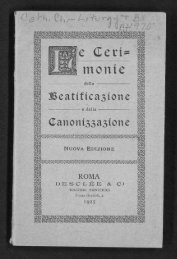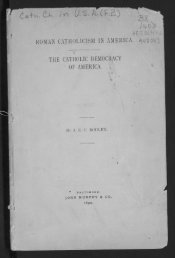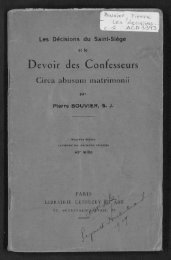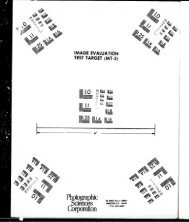Fabiola : or, The church of the catacombs - Digital Repository Services
Fabiola : or, The church of the catacombs - Digital Repository Services
Fabiola : or, The church of the catacombs - Digital Repository Services
You also want an ePaper? Increase the reach of your titles
YUMPU automatically turns print PDFs into web optimized ePapers that Google loves.
tyrology, now swelled out, by <strong>the</strong> additions <strong>of</strong> later ages.*<br />
An <strong>or</strong>din.<br />
"f <strong>the</strong> l>ok hardly knows <strong>the</strong> imp<strong>or</strong>tance<br />
<strong>of</strong> <strong>the</strong>se iiulii'iitiouB; f<strong>or</strong> <strong>the</strong>y have served to verify several<br />
o<strong>the</strong>rwise dubious cemeteries. Ano<strong>the</strong>r clnas <strong>of</strong> valuable<br />
writers also comes to our aid; but bef<strong>or</strong>e mentioning <strong>the</strong>m we<br />
will glance at <strong>the</strong> changes which this devotion produced in <strong>the</strong><br />
cemeteries. First, commodious entrances, with easy staircases,<br />
were made; <strong>the</strong>n walls were built to supp<strong>or</strong>t <strong>the</strong> crumbling<br />
galleries; and, from time to time, funnel-shaped apertures in<br />
<strong>the</strong> vaults were opened to admit light and air. Finally, basili-<br />
cas <strong>or</strong> <strong>church</strong>es were erected over <strong>the</strong>ir entrances, generally<br />
leading immediately to <strong>the</strong> principal tomb, <strong>the</strong>n called <strong>the</strong><br />
confession <strong>of</strong> <strong>the</strong> <strong>church</strong>. <strong>The</strong> pilgrim thus, on arriving at<br />
<strong>the</strong> holy city, visited each <strong>of</strong> <strong>the</strong>se <strong>church</strong>es, a custom yet<br />
practised; descended below, and without having to grope his<br />
way about, went direct, by well-constructed passages, to <strong>the</strong><br />
principal martyr's shrine, and so on to o<strong>the</strong>rs, perhaps equally<br />
objects <strong>of</strong> reverence and devotion. .<br />
During this period, no tomb was allowed to be opened,<br />
no body to be extracted. Through apertures made into <strong>the</strong><br />
grave, handkerchiefs <strong>or</strong> scarfs, called branded, were intro-<br />
duced, to touch <strong>the</strong> martyr's relics and <strong>the</strong>se were carried to<br />
;<br />
distant countries, to be held in equal reverence. No wonder<br />
that St. Ambrose, St. Gaudentius, and o<strong>the</strong>r bishops, should<br />
have found it so difficult to obtain bodies, <strong>or</strong> large relics <strong>of</strong> martyrs<br />
f<strong>or</strong> <strong>the</strong>ir <strong>church</strong>es. Ano<strong>the</strong>r s<strong>or</strong>t <strong>of</strong> relics consisted <strong>of</strong> what<br />
was called familiarly <strong>the</strong> oil <strong>of</strong> a martyr, that is, <strong>the</strong> oil, <strong>of</strong>ten<br />
mixed with a balsam, which burned in a lamp beside his tomb.<br />
Often a round stone pillar, three feet <strong>or</strong> so in height, and<br />
scooped out at <strong>the</strong> top, stands beside a monument ; probably<br />
to hold <strong>the</strong> lamp, <strong>or</strong> serve f<strong>or</strong> <strong>the</strong> distribution <strong>of</strong> its contents.<br />
St. Greg<strong>or</strong>y <strong>the</strong> Great wrote to Queen <strong>The</strong>odelinda, that he sent<br />
her a collection <strong>of</strong> <strong>the</strong> oils <strong>of</strong> <strong>the</strong> popes who were martyrs.<br />
<strong>The</strong> list which accompanied <strong>the</strong>m was copied by Mabillon in <strong>the</strong><br />
treasury <strong>of</strong> Monza, and republished by Euinart.t It exists<br />
<strong>the</strong>re yet, toge<strong>the</strong>r with <strong>the</strong> very phials containing <strong>the</strong>m, sealed<br />
up in metal tubes.<br />
This jealousy <strong>of</strong> disturbing <strong>the</strong> saints, is displayed most<br />
beautifully in an incident, related by St. Greg<strong>or</strong>y <strong>of</strong> Tours.<br />
Among <strong>the</strong> martyrs most hon<strong>or</strong>ed in <strong>the</strong> ancient Koman Church<br />
were St. Chrysanthus and Daria. <strong>The</strong>ir tombs became so celebrated<br />
f<strong>or</strong> cures, that <strong>the</strong>ir fellow-Christians built (that is excavated)<br />
over <strong>the</strong>m a chamber, with a vault <strong>of</strong> beautiful w<strong>or</strong>kmanship,<br />
where crowds <strong>of</strong> w<strong>or</strong>shippers assembled. This was<br />
discovered by <strong>the</strong> hea<strong>the</strong>ns,, and <strong>the</strong> emper<strong>or</strong> closed <strong>the</strong>m in,<br />
walled up <strong>the</strong> entrance, and from above, probably through <strong>the</strong><br />
luminare, <strong>or</strong> ventilating shaft, showered down earth and stones,<br />
and buried <strong>the</strong> congregation alive, as <strong>the</strong> two holy martyrs<br />
had been bef<strong>or</strong>e <strong>the</strong>m. <strong>The</strong> place was unknown at <strong>the</strong> peace<br />
<strong>of</strong> <strong>the</strong> Church, till discovered by Divine manifestation. But<br />
instead <strong>of</strong> being permitted to enter again into this hallowed<br />
spot, pilgrims were merely allowed to look at it, through a window<br />
opened in <strong>the</strong> wall, so as to see not only, <strong>the</strong> tombs <strong>of</strong> <strong>the</strong><br />
martyrs, but also <strong>the</strong> bodies <strong>of</strong> those who had been buried<br />
alive at <strong>the</strong>ir shrines. And as <strong>the</strong> cruel massacre had taken<br />
place while preparations were being made f<strong>or</strong> oblation <strong>of</strong> <strong>the</strong><br />
holy Eucharist, <strong>the</strong>re were still to be seen lying about, <strong>the</strong><br />
silver cruets in which <strong>the</strong> wine was brought f<strong>or</strong> that spotless<br />
sacrifice. \<br />
One <strong>or</strong><br />
this:<br />
two entries from <strong>the</strong> old Kalendarium Komanum will illustrate<br />
"ill. Non. Mart. Lucii in CaUisti.<br />
vt Id. Dec. Eutichiani in CaDisti.<br />
xiii. Kal. Feb. Fabianl in Callisti, et Sebastian! ad Catacmnbau.<br />
viii. Id. Aug. Systiin Callisti."<br />
We have extracted <strong>the</strong>se entries <strong>of</strong> depositions in <strong>the</strong> cemetery <strong>of</strong> Callistus be.<br />
cause, while ac'mlly writing this chapter, we have received news <strong>of</strong> <strong>the</strong> dis.<br />
covery <strong>of</strong> <strong>the</strong> tombs and lapidary inscriptions <strong>of</strong> every one <strong>of</strong> <strong>the</strong>se Popes,<br />
toge<strong>the</strong>r with those <strong>of</strong> St. An<strong>the</strong>ms, in one chapel <strong>of</strong> <strong>the</strong> newly-ascertained<br />
cemetery <strong>of</strong> Calliatus, with an inscription iu verse by St. Damasus :<br />
"Prid. Kul. Jun. Sylvestri in Priscillffi.<br />
iv. Id. (Ang ) Laurentii in Tiburtina.<br />
Ui. Kal. Dec. Saturnini in Thrasoniu."<br />
Publlnhed by Buinart, Acta, t<strong>or</strong>n. iii.<br />
t Acta Martyr, t<strong>or</strong>n. ill.<br />
1 3. Cirotf 'J'nr, in. dp Gl<strong>or</strong>ia Mart. lib. i. c. 2fl. ap. March], p. Rl. One would<br />
apply St. Damasns's epigram on <strong>the</strong>se martyrs to ibis uccurrrence, Cairn xxviii.<br />
Tin-: CHURCH OF mi': CATACOMBS. 39<br />
It is clear that pilgrims res<strong>or</strong>ting to B<strong>or</strong>ne would want a handbook<br />
to <strong>the</strong> cemeteries that <strong>the</strong>y might kuow what <strong>the</strong>y had to<br />
visit. It is likewise but natural that, on <strong>the</strong>ir return home, <strong>the</strong>y<br />
may have sought to edify <strong>the</strong>ir less f<strong>or</strong>tunate neighb<strong>or</strong>s by<br />
giving iiu account <strong>of</strong> what <strong>the</strong>y had seen. Acc<strong>or</strong>dingly <strong>the</strong>re<br />
exist, no less f<strong>or</strong>tunately f<strong>or</strong> us than f<strong>or</strong> <strong>the</strong>ir untravellod neighb<strong>or</strong>s,<br />
several rec<strong>or</strong>ds <strong>of</strong> this character. <strong>The</strong> first place, among<br />
<strong>the</strong>se, is held by catalogues compiled in <strong>the</strong> fourth century ; one,<br />
<strong>of</strong> Uio places <strong>of</strong> sepulture <strong>of</strong> Koman Pontiffs, <strong>the</strong> o<strong>the</strong>r <strong>of</strong> mar-<br />
After <strong>the</strong>se comes throe distinct guides to <strong>the</strong> cata-<br />
tyrs. 1'<br />
combs <strong>the</strong> m<strong>or</strong>e ; interesting because <strong>the</strong>y take different rounds,<br />
yet agree marvellously in <strong>the</strong>ir account.<br />
To show <strong>the</strong> value <strong>of</strong> <strong>the</strong>se documents, and describe <strong>the</strong><br />
changes which took place in <strong>the</strong> <strong>catacombs</strong> during <strong>the</strong> si<br />
period <strong>of</strong> <strong>the</strong>ir hist<strong>or</strong>y, we will give a brief account <strong>of</strong> one discovery,<br />
in <strong>the</strong> cemetery where we have have left our little<br />
party. Among <strong>the</strong> rubbish near <strong>the</strong> entrance <strong>of</strong> a catacomb,<br />
<strong>the</strong> name <strong>of</strong> which was yet doubtful, and which had been taken<br />
f<strong>or</strong> that <strong>of</strong> Pnetextatus, was found a fragment <strong>of</strong> a slab <strong>of</strong> mar-<br />
ble which had been broken across obliquely, from left to<br />
right, with <strong>the</strong> following<br />
letters :<br />
\NELII MARTYRIS<br />
<strong>The</strong> young Cavalier de Bossi at once declared that this<br />
was part <strong>of</strong> <strong>the</strong> sepulchral inscription <strong>of</strong> <strong>the</strong> holy Pope<br />
C<strong>or</strong>nelius ; that probably his tomb would be found below,<br />
in a distinguished f<strong>or</strong>m ; and that as <strong>the</strong> itineraries<br />
above mentioned concurred in placing it in <strong>the</strong> cemetery<br />
<strong>of</strong> Callistus, this, and not <strong>the</strong> one at St. Sebastian's, a few<br />
hundred yards <strong>of</strong>f, must claim <strong>the</strong> hon<strong>or</strong> <strong>of</strong> that name. He<br />
went fur<strong>the</strong>r, and f<strong>or</strong>etold that as <strong>the</strong>se w<strong>or</strong>ks pronounced St.<br />
Cyprian to be buried near C<strong>or</strong>nelius, <strong>the</strong>re would be found<br />
something at <strong>the</strong> tomb which would account f<strong>or</strong> that idea ; f<strong>or</strong><br />
it was known that his body rested in Africa. It was not long<br />
bef<strong>or</strong>e every prediction was verified. <strong>The</strong> great staircase dis-<br />
coveredj was found to lead at once to a wider space, carefully<br />
secured by brick-w<strong>or</strong>k <strong>of</strong> <strong>the</strong> time <strong>of</strong> peace, and provided with<br />
light and air from above. On <strong>the</strong> left was a tomb, cut like<br />
o<strong>the</strong>rs in <strong>the</strong> rock, without any exteri<strong>or</strong> arch over it. It was,<br />
however, large and ample; and except one, very high above it,<br />
<strong>the</strong>re were no o<strong>the</strong>r graves below, <strong>or</strong> over, <strong>or</strong> at <strong>the</strong> sides. <strong>The</strong><br />
remaining p<strong>or</strong>tion <strong>of</strong> <strong>the</strong> slab was found within it ; <strong>the</strong> first<br />
piece was brought from <strong>the</strong> Kircherian Museum, where it had<br />
been deposited, and exactly fitted to it ; and both covered <strong>the</strong><br />
tomb, thus :<br />
MARTYRIS<br />
Below, reaching from <strong>the</strong> lower edge <strong>of</strong> this stone to <strong>the</strong> ground<br />
was a marble slab covered with an inscription, <strong>of</strong> which only<br />
<strong>the</strong> left-hand end remains, <strong>the</strong> rest being broken <strong>of</strong>f and lost.<br />
Above <strong>the</strong> tomb was ano<strong>the</strong>r slab let into <strong>the</strong> sand-stone, <strong>of</strong><br />
which <strong>the</strong> right-hand end . exists, and a few m<strong>or</strong>e fragments<br />
have been recovered in <strong>the</strong> rubbish ; not enough to make out<br />
<strong>the</strong> lines, but sufficient to show it was an inscription in verse,<br />
by Pope Damasus. How is this auth<strong>or</strong>ship traceable ? Very<br />
easily. Not only do we know that this holy pope, already men-<br />
tioned, took pleasure in putting verses, which he loved to<br />
write, on <strong>the</strong> tombs <strong>of</strong> martyrs, but || <strong>the</strong> number <strong>of</strong><br />
inscrip-<br />
* Published by Bncheriua in 1634.<br />
t (Of)<br />
. . nelius martyr.<br />
J <strong>The</strong> crypt, we believe, was discovered bef<strong>or</strong>e <strong>the</strong> stain.<br />
5 Of C<strong>or</strong>nelius Martyr Bishop.<br />
I 'ibex f<strong>or</strong>m <strong>the</strong> great bulk <strong>of</strong> his extant w<strong>or</strong>ts in vertt.



